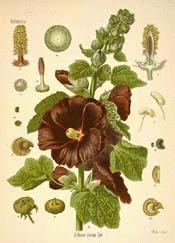
Messidor 7
The plant of the day in the French Republican calendar is the cucumber. I am not a big fan of cucumbers (I pick them out of my salads) and we can’t easily grow cucumbers here in the Northwest, so I’m honoring the flower of the day in Rosa’s Dial: the glorious hollyhock.
The hollyhock belongs to the family Malvaceae, which also includes the marsh mallow and the hibiscus. It from the genus Althea (which means “healer”), species rosea. (There is a Grateful Dead song that addresses a woman named Althea and the Cavalier poet Richard Lovelace also wrote a poem to Althea in 1649—both can be found at this interesting web site:
http://arts.ucsc.edu/GDEAD/AGDL/althea.html
Laura Martin says the name hollyhock comes from the Anglo-Saxon for holy hock (a name for Mallows) and that it was considered holy because it grew plentifully in the Holy Land--supposedly the Crusaders brought it back with them). That sounds like a spurious explanation to me, that is an explanation made up to explain the name.
Hollyhocks originated in China where they were grown in gardens but also used for food: the leaves were cooked for spring greens and the flower buds were a delicacy. The The Romans also ate hollyhock leaves and used it as a strewing herb.
The juice of the plant was considered a demulcent and used in cough syrups and as a gargle for any problems with the mouth and throat. The flowers have been used to make dye. Jeanne Rose says the violet flowers produce a lovely pale periwinkle blue.
Denise Diamond in her book Living with Flowers suggests sandwiches made with hollyhock blossoms, sliced avocado and mile cheese, topped with alfalfa sprouts.
I do not know how to make hollyhock dolls because there were no hollyhocks around where I was growing up (the San Fernando Valley). If you are deprived like me, here are some instructions:
http://www.almanac.com/garden/crafts/hollydoll.php
Chelsie Vandaveer in her great web site on plant lore tells the legend of Priscilla’s hollyhock which grows in Oklahoma:
http://www.killerplants.com/herbal-folklore/20020429.asp
Mrs. Grieve has very little to say about hollyhocks but much to say about mallows:
http://www.botanical.com/botanical/mgmh/h/holhoc30.html
In the language of the flowers, hollyhock means abundance, fertility, mother of the family, and in some versions, ambition, particularly female ambition. Makes you think doesn’t it? What is the difference between female ambition and male ambition?
Do you know of the wonderful retreat center called Hollyhock? Someday I hope to take a class there (or teach one—even better!).
http://www.hollyhock.ca/
And Frank Lloyd Wright designed a house in LA called Hollyhock House:
http://www.galinsky.com/buildings/hollyhock/index.htm
The illustration comes from Mrs. Grieve’s herbal at this website:
http://www.botanical.com/botanical/mgmh/h/holhoc30.html
References:
Jeanne Rose, Herbs & Things, Grosset & Dunlap 1972
Martin, Laura C, Garden Flower Folklore, Globe Pequot Press 1987
Seaton, Beverly, The Language of the Flowers: A History, University Press of Virginia, 1995 f
No comments:
Post a Comment